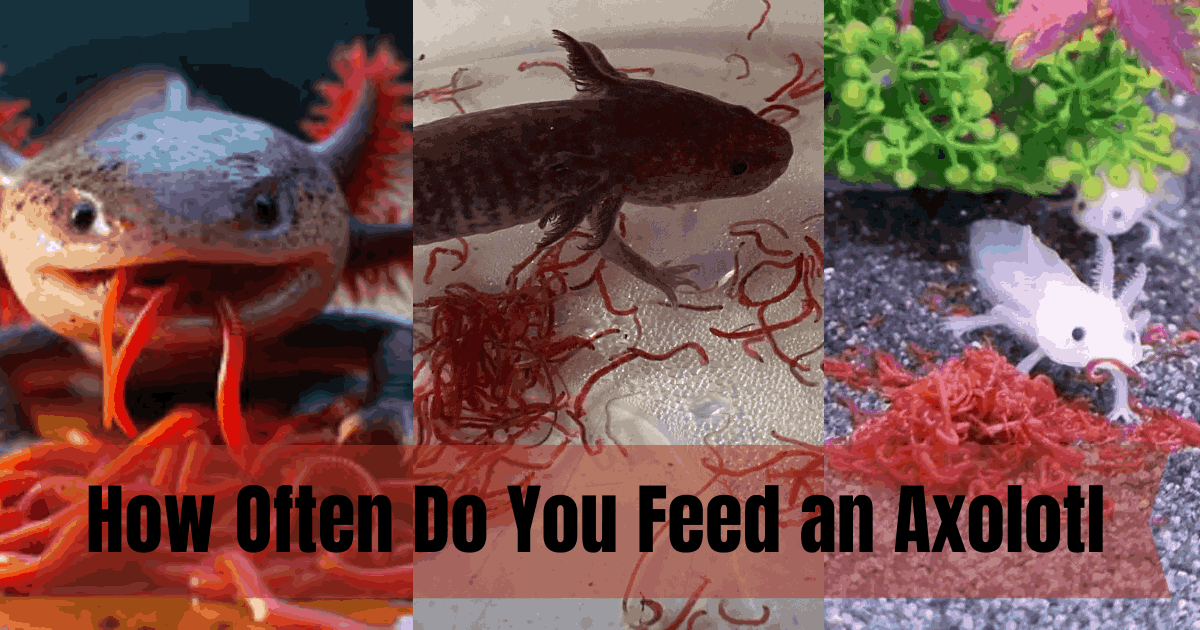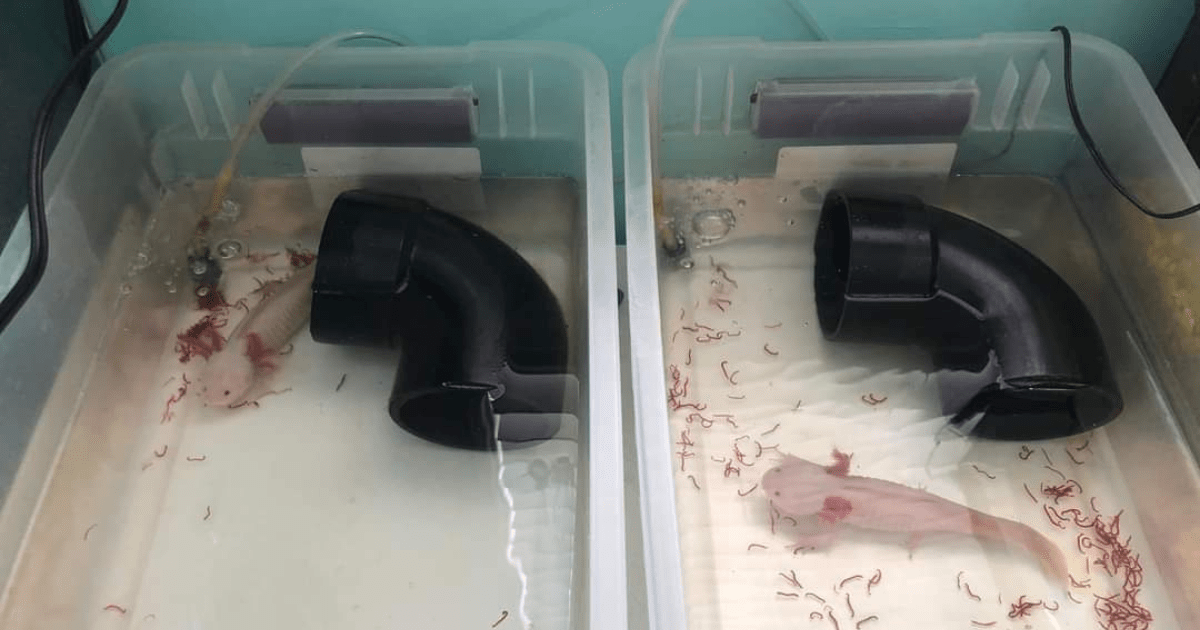Axolotls, often referred to as “Mexican walking fish,” are fascinating amphibians that have captured the hearts of many aquarium enthusiasts. With their unique appearance and regenerative abilities, they are both intriguing and demanding pets. One of the most crucial aspects of axolotl care is understanding their dietary needs. This comprehensive guide will delve into the shocking truths about how often do you feed an axolotl or how often should he be fed, ensuring you provide the best care for your aquatic friend.
Contents
- Understanding Axolotl’s Dietary Needs
- How Often Do You Feed an Axolotl? Shocking Truths!
- Ideal Food Options for Axolotls
- Feeding Techniques for Optimal Health
- Signs of a Healthy Axolotl
- Common Feeding Mistakes to Avoid
- Adjusting Diets for Sick Axolotls
- Seasonal Feeding Variations
- Feeding Schedules for Baby Axolotls
- Feeding Adult Axolotls
- Feeding Senior Axolotls
- The Impact of Tank Conditions on Feeding
- Using Supplements for Axolotls
- Feeding in Group Settings
- Troubleshooting Feeding Issues
- Feeding Myths and Misconceptions
- Creating a Feeding Routine
- Environmental Enrichment and Feeding
- Understanding Axolotl Metabolism
- Biosecurity Measures for Feeding
- The Role of Enclosure Design in Feeding
- Feeding Axolotls in Different Life Stages
- Caring for Malnourished Axolotls
- Feeding and Breeding
- Monitoring Long-Term Health through Diet
- Conclusion
- Axolotl Feeding FAQs
Understanding Axolotl’s Dietary Needs
Axolotls have specific dietary requirements that stem from their natural habitat and evolutionary history. Understanding these needs is the first step in providing proper care.
Natural Diet in the Wild
In the wild, axolotls are opportunistic feeders. They primarily consume small fish, worms, insects, and crustaceans.
Their diet is rich in protein, which supports their growth and regenerative capabilities. Replicating this diet in captivity is essential for their health.
How Often Do You Feed an Axolotl? Shocking Truths!
The frequency of feeding axolotls varies depending on their age and health. Here’s a detailed look at what you need to know.

Feeding Frequency Based on Age
- Juveniles (0-6 months): Young axolotls require daily feeding. Their rapid growth demands a constant supply of nutrients.
- Sub-Adults (6-12 months): As they approach adulthood, feeding can be reduced to every other day.
- Adults (1 year+): Adult axolotls typically thrive on a feeding schedule of 2-3 times per week.
Adjusting Feeding Schedules
It’s crucial to adjust feeding schedules based on the individual needs of your axolotl.
Factors such as activity level, health status, and environmental conditions can influence how often you should feed them.
- Read More:- How Long Do Axolotls Live?
Overfeeding and Its Dangers
Overfeeding can lead to obesity, poor water quality, and health issues like fatty liver disease. It’s vital to monitor portion sizes and ensure you’re not giving more food than necessary.
Ideal Food Options for Axolotls
Choosing the right food is as important as the feeding frequency. Here are some ideal food options.
Live Food Choices
- Earthworms: A favorite among axolotls, rich in protein.
- Bloodworms: Suitable for both juveniles and adults.
- Daphnia and Brine Shrimp: Great for young axolotls.
Commercial Food Options
- Pellets: Specifically formulated for axolotls, these are convenient and balanced.
- Frozen Foods: Options like frozen bloodworms are easy to store and use.
Homemade Food Tips
Creating a balanced homemade diet can be rewarding. Consider blending shrimp, fish, and other protein sources to make nutritious food blocks.
Feeding Techniques for Optimal Health
The way you feed your axolotl can impact their health and behavior.
Hand-Feeding vs. Free-Range Feeding
Hand-feeding allows for better portion control and bonding with your pet. Free-range feeding, where food is scattered in the tank, encourages natural hunting behaviors.
Using Feeding Tools
Tools like feeding tongs can help deliver food directly to your axolotl, reducing waste and maintaining water quality.
Monitoring Eating Habits
Regularly observe your axolotl’s eating habits to ensure they’re consuming food appropriately. Changes in appetite can indicate health issues.
- Read More:-Life Cycle of an Axolotl with Pictures
Signs of a Healthy Axolotl
Identifying a healthy axolotl involves monitoring both physical and behavioral indicators.
Physical Indicators
- Bright Colors: A healthy axolotl has vibrant, clear skin.
- Active Movement: Regular, active swimming and exploring.
- Clear Eyes and Gills: No signs of cloudiness or irritation.
Behavioral Signs
- Consistent Appetite: Regularly eating with enthusiasm.
- Normal Resting Patterns: Alternating between periods of activity and rest.
Common Feeding Mistakes to Avoid
Avoid these pitfalls to ensure your axolotl’s diet supports their health.
Overfeeding
Leads to obesity and water quality issues. Stick to recommended portion sizes.
Underfeeding
Can result in malnutrition and stunted growth. Ensure your axolotl gets enough food.
Inappropriate Food Choices
Feeding unsuitable foods can cause digestive problems. Stick to recommended diets.
Adjusting Diets for Sick Axolotls
Sick axolotls may require dietary adjustments to support their recovery.
Common Health Issues
- Fungal Infections: May need softer, easier-to-digest foods.
- Parasites: Adjust diet to include more immune-boosting foods.
Dietary Adjustments for Illness
Consider incorporating supplements or changing food types to accommodate their needs.
Consulting a Vet
Always consult a vet for a proper diagnosis and treatment plan tailored to your axolotl’s condition.
Seasonal Feeding Variations
Feeding requirements can change with the seasons.
Summer Feeding Tips
Higher temperatures can increase metabolism, necessitating more frequent feeding.
Winter Feeding Adjustments
Lower temperatures can slow metabolism, reducing the need for frequent feeding.
- Read More:- What is an Axolotl?
Feeding Schedules for Baby Axolotls
Baby axolotls have different nutritional needs compared to adults.
Frequency and Portion Sizes
Feed baby axolotls small amounts daily to support rapid growth.
Transitioning to Adult Diets
Gradually introduce larger food items and reduce feeding frequency as they grow.
Feeding Adult Axolotls
Understanding the needs of adult axolotls is crucial for their long-term health.
Optimal Feeding Frequency
Feed adults 2-3 times per week to maintain a healthy weight and avoid overfeeding.
Portion Control
Monitor and adjust portion sizes based on activity levels and health status.
Feeding Senior Axolotls
Senior axolotls may have changing dietary needs.
Dietary Changes with Age
Older axolotls might require softer foods or supplements to aid digestion.
Maintaining Appetite in Older Axolotls
Ensure food is easily accessible and appealing to maintain their interest in eating.
The Impact of Tank Conditions on Feeding
Tank conditions can significantly affect your axolotl’s feeding habits.
Water Quality and Its Effect
Poor water quality can lead to loss of appetite and health issues. Maintain clean water to encourage healthy eating.
Temperature Considerations
Keep the tank temperature within the optimal range to support normal metabolism and feeding behavior.
Using Supplements for Axolotls
Supplements can enhance your axolotl’s diet when used correctly.
Necessary Vitamins and Minerals
Consider calcium and vitamin supplements to support bone health and overall vitality.
How to Administer Supplements
Mix supplements with food or use liquid forms that can be added to the water.
Feeding in Group Settings
Feeding multiple axolotls in the same tank requires careful management.
Managing Multiple Axolotls
Ensure all axolotls get enough food by monitoring feeding sessions closely.
Preventing Food Aggression
Provide ample space and multiple feeding spots to reduce competition and aggression.
Troubleshooting Feeding Issues
Addressing feeding problems promptly is essential for your axolotl’s health.
Refusal to Eat
Identify and address potential causes, such as water quality, stress, or illness.
Regurgitation and Other Problems
Consult a vet if your axolotl regurgitates food or shows other signs of distress.
Feeding Myths and Misconceptions
Separating fact from fiction is crucial for proper axolotl care.
Common Myths Debunked
Address and correct prevalent myths about axolotl feeding to ensure accurate information.
Reliable Sources of Information
Refer to trusted sources and experts for accurate, up-to-date feeding guidelines.
Creating a Feeding Routine
Establishing and maintaining a feeding routine benefits both you and your axolotl.
Establishing a Schedule
Create a consistent feeding schedule that fits your axolotl’s needs and your lifestyle.
Sticking to the Routine
Consistency is key to maintaining your axolotl’s health and well-being.
Environmental Enrichment and Feeding
Enrichment activities can enhance your axolotl’s feeding experience.
Enrichment Activities
Incorporate activities that stimulate natural hunting and foraging behaviors.
Stimulating Natural Behaviors
Encourage behaviors that mimic their natural environment to keep your axolotl engaged and healthy.
Understanding Axolotl Metabolism
Axolotl metabolism affects how they process food and nutrients.
Metabolic Rates
Understanding your axolotl’s metabolic rate helps tailor their feeding schedule.
Influencing Factors
Factors such as age, health, and environmental conditions can influence metabolism.
Biosecurity Measures for Feeding
Preventing disease transmission is crucial for maintaining a healthy axolotl.
Preventing Disease Transmission
Implement strict hygiene practices when handling food and feeding tools.
Safe Handling Practices
Wash hands and tools thoroughly before and after feeding to reduce the risk of contamination.
The Role of Enclosure Design in Feeding
A well-designed enclosure can make feeding easier and more efficient.
Designing for Easy Feeding
Arrange the tank to facilitate easy access to food and minimize waste.
Preventing Food Waste
Remove uneaten food promptly to maintain water quality and prevent spoilage.
Feeding Axolotls in Different Life Stages
Different life stages have unique dietary requirements.
From Eggs to Adults
Understand the dietary needs from hatching through adulthood to ensure proper growth and development.
Changing Needs Over Time
Adjust the diet and feeding schedule as your axolotl grows and matures.
Caring for Malnourished Axolotls
Addressing malnutrition requires careful management and rehabilitation.
Identifying Malnutrition
Look for signs such as weight loss, lethargy, and poor skin condition.
Rehabilitation Strategies
Implement a targeted feeding plan to restore health and vitality.
Feeding and Breeding
Breeding axolotls have specific nutritional needs.
Nutritional Needs for Breeding Axolotls
Provide a nutrient-rich diet to support reproductive health and offspring development.
Post-Breeding Care
Continue a high-quality diet to aid recovery after breeding.
Monitoring Long-Term Health through Diet
Regular monitoring ensures your axolotl remains healthy over the long term.
Keeping Health Records
Track feeding habits, health changes, and dietary adjustments in a log.
Adjusting Diets as Needed
Make necessary changes to the diet based on health and behavior observations.
Conclusion
Feeding your axolotl correctly is crucial for their health and happiness. By understanding their dietary needs, adjusting feeding schedules, and choosing the right foods, you can ensure your axolotl thrives.
Regular monitoring and adjustments will help maintain their well-being throughout their life stages. Remember, a well-fed axolotl is a happy and healthy axolotl!
Axolotl Feeding FAQs
How often do axolotls eat?
Axolotls’ feeding frequency depends on their age and health. Juveniles need daily feeding, while adults eat 2-3 times per week.
What is the best food for axolotls?
Axolotls thrive on a diet of earthworms, bloodworms, and specially formulated pellets.
Can axolotls be overfed?
Yes, overfeeding can lead to obesity and health issues. It’s important to monitor portion sizes.
How to tell if an axolotl is hungry?
Signs of hunger include increased activity and searching behavior. They may also become more responsive to feeding times.
Do axolotls need live food?
While not essential, live food can enrich their diet and stimulate natural hunting behaviors.
How to feed a sick axolotl?
Consult a vet for a tailored feeding plan, often involving softer, easier-to-digest foods and potential supplements.



